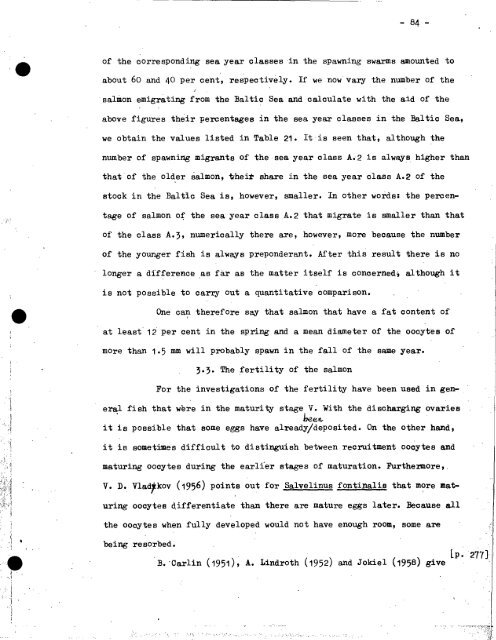Translation Series No.1211
Translation Series No.1211
Translation Series No.1211
You also want an ePaper? Increase the reach of your titles
YUMPU automatically turns print PDFs into web optimized ePapers that Google loves.
- 84 -<br />
of the corresponding sea year classes in the spawning swarms amounted to<br />
about 60 and 40 per cent, respectively. If we now vary the number of the<br />
salMon emigrating from the Baltic Sea and calculate with the aid of the<br />
above figures their percentages in the sea year classes in the Baltic Sea,<br />
we obtain the values listed in Table 21. It.is seen that, although the<br />
number of spawning migrants of the sea year class Ai2 is always, higher than<br />
that of the older Salmon, their Share in the sea year class A.2 of the<br />
stock in the Baltic Sea is, however, smaller. In other words: the percenr.<br />
tage of salmon of the sea year class A.2 that migrate is smaller than that<br />
of the class A.3, numerically there are, however, more because the number<br />
of the younger fish is always preponderant. After thia result there is no<br />
* longer a dïfference .as far as the matter itself is concernedii although it<br />
is not possible to carry out a quantitative comparison. *<br />
One can therefore say that salmon that have a fat content of<br />
at least . 12 per cent in the spring and a mean diameter of the oocytes of<br />
more than 1.5 mm will probably spawn in the fall of the same year.<br />
. 3.3. The fertility of the salmon<br />
For the investigations of the fertility have been used in gen-<br />
eral fish that were in the maturity stage V. With the discharging ovaries<br />
been.<br />
it is possible that some eggs have already/deposited. On the other hand,<br />
it is sometimes difficult to distinguish between recruitment oocytes and<br />
maturing oocytes during the earlier stages of maturation. Furthermore,.<br />
V. D. Vladekov (1956) points out for Salvelinus fontinalis that more mat-<br />
uring oocytes differentiate than there are mature eggs later. Because all<br />
the oocytes when fully developed would not have enough room, some are<br />
being resorbed.<br />
B. Carlin (1951), A. Lindroth (1952) and Jokiel (1950 give<br />
11). 277]
















